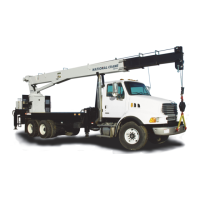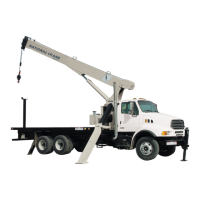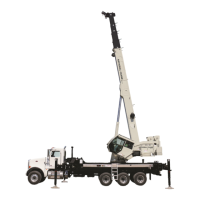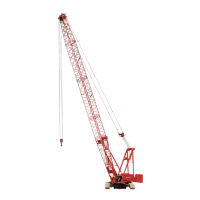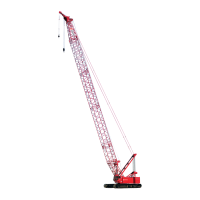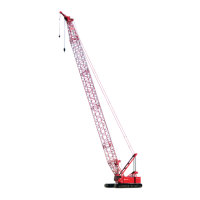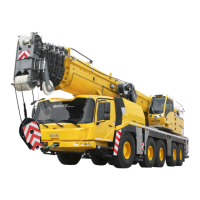OPERATING CONTROLS 1400H OPERATOR AND SERVICE MANUAL
2-22 Published 10-30-2014 Control # 040-09
FIGURE B
General Rules When Operating the Hoist
1. Always operate the hoist control as if the anti-two-block
is not operational. Payout the loadline while extending
the boom and reduce hoist speed and maintain safe
clearance at the boom tip when hoisting up. Do not rely
on anti-two-block system to eliminate two blocking. Use
the system as a backup to safe operation.
2. Make certain the hoist cable is not twisted or kinked and
that cable is properly seated on the drum and in the
sheaves.
3. Before lifting a load, always make certain that three full
wraps of rope will remain on the drum at all times
throughout the lift.
4. When lifting a load approaching the rated hoist load,
raise the load a few inches and return the control to
neutral to determine if the brake is working properly.
5. Do not drag loads in any direction with the hoist.
6. Never attempt to lift loads which are not loose and free,
i.e. frozen down material or poles out of ground.
7. Maintain tension on the loadline at all times to prevent
the cable from becoming twisted or kinked or improperly
seated on the hoist drum or sheaves. Start and stop load
movement slowly and smoothly especially when
operating on high speed mode with multi-part reeving to
avoid bird caging the load line on the hoist drum.
Lifting the Load
After the vehicle and crane have been properly set up as
close to the work as possible, again check the work area for
electric power lines and other obstructions so that proper
clearances can be maintained. (See Safety Rules.) If load is
not visible to operator throughout lift, a person must be
appointed to use hand signals as shown on the last page of
this section. Proceed with lifting the load.
The following procedure is a typical method which
should be used to determine the crane's ability to handle a
load.
1. Determine the weight of the
load and load handling
equipment. Use a
dynamometer whenever
load weight is in question
and be sure to include
weight of blocks and slings
as part of load weight.
2. Refer to the hoist data chart for correct loadline reeving.
Hoist capacity and crane capacity are separate. Be sure
hoist is properly reeved for the load to be lifted.
The RCL will warn the operator when hoist and
loadline overload occurs but will allow the boom up
function to continue to operate. Booming up a hoist and
loadline overload in areas where the boom capacity
exceeds the loadline capacity can cause serious
damage to the hoist and loadline. Always reeve the
loadline properly for the load to be lifted.
3. Determine the furthest radius from centerline of rotation
and greatest height that the load will have to be handled.
Crane maximum rated loads decrease as radius and
height increase. Determining the furthest distance and
height a load will have to be handled at will determine
what maximum loads can be handled. Moving the crane
hook block to the furthest load-setting point, reading
boom length and boom angle from the RCL, then
referring to the range chart will give an approximation of
the load radius and height.
4. Refer to the load chart or RCL to determine that the load
is within the rated capacity of the crane for the
approximate radius and height. By knowing boom
length, approximate radius and load weight, a glance at
the load chart will tell you if you are within rated capacity
of the machine. If load and radius are close to maximum,
measure the radius to determine the exact distance from
center line of rotation to load-setting point. Remember
when working between listed radii or boom lengths, use
the smallest rated capacity.
NOTICE
• Do not deadhead line block
against boom tip when extending
boom.
• Keep at least 3 wraps of loadline
on drum at all times.
• Use only 5/8 inch diameter rotation
resistant cable with 45,400 lb
breaking strength on this machine.
• Maximum capacity with “burst of
speed” is 4,400 lb.
1 PART LINE 2 PART LINE 3 PART LINE
4 PART LINE 5 PART LINE
6 PART LINE
MAX. PULL
9,000 lb
MAX. PULL
18,000 lb
MAX. PULL
27,000 lb
MAX. PULL
36,000 lb
MAX. PULL
45,000 lb
MAX. PULL
54,000 lb
7 PART LINE
MAX. PULL
63,000 lb
8 PART LINE
MAX. PULL
66,000 lb
BLOCK
SLINGS
+
LOAD
+
TOTAL RATED LOAD
DANGER
!
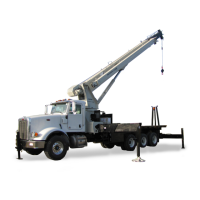
